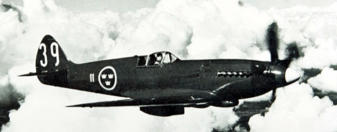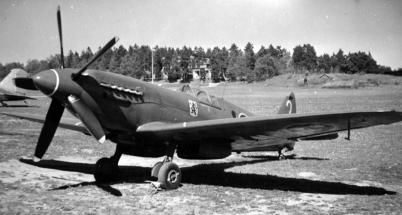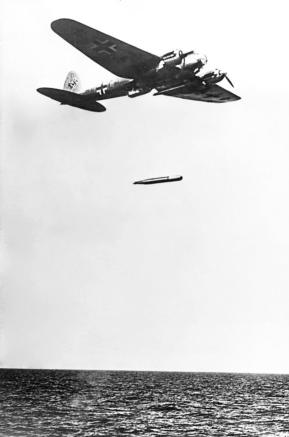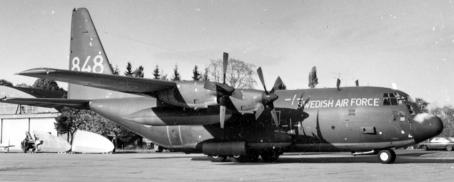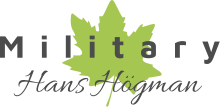

Copyright © Hans Högman 2022-06-12


Swedish Combat Aircraft -
Propeller Aircraft
Reconnaissance Aircraft
Reconnaissance aircraft, sometimes called spy
planes, are combat aircraft that carry equipment
for reconnaissance, usually photo reconnaissance
but also signal reconnaissance.
List of Reconnaissance Aircraft in the
Swedish Air Force
•
S 1 - FVM S 21, 16 in Swedish service
•
S 2 - Heinkel S.I Hansa, 8 in Swedish service
•
S 3 - Heinkel S.II Hansa, 6 in Swedish service
•
S 4 - Heinkel HE 4 Hansa, 1 in Swedish service
•
S 5 - Heinkel HE 5 Hansa, 40 in Swedish service
•
S 6 - Fokker C.V E,
•
S 7 - Hawker Hart, 3 in Swedish service 1934 -
1947
•
S 8 - Svenska Aero SA-12
•
S 9 - Hawker Osprey, 6 st in Swedish service
1934 - 1947
•
S 12 - Heinkel He 114, 12 in Swedish service
•
S 14 - Fieseler Fi 156 Storch, 26 in Swedish
service
•
S 16 - Caproni Ca 313, 80 st in Swedish service
1940 - 1945
•
S 17B - Saab 17, 121 in Swedish service 1942 -
1952
•
S 18A - Saab 18, 55 in Swedish service 1944 –
1957
•
S 22 - FFVS J 22, 9 in Swedish service 1943 -
1952
•
S 26 - North American P-51 Mustang, 12 st in
Swedish service 1945 - 1953
•
S 31 - Supermarine Spitfire Mk XIX, 50 st in
Swedish service 1948- 1955
Supermarine Spitfire PR Mk XIX S 31
The Supermarine Spitfire was a British fighter
aircraft designed by Reginald Joseph Mitchell in the
1930s. It is best known for its role in the Battle of
Britain and was one of the most important fighter
aircraft of the Second World War.
The third generation of Spitfires had the larger and
more powerful Rolls-Royce Griffon engine.
Because the Griffon engine was larger, the bonnet
had to be redesigned with two ridges for the
cylinder heads, making the last versions of the
Spitfire more similar to the original Supermarine
S.6. The Griffon engine had higher torque than the
Merlin engine, which meant that propellers with
four or five blades could be used.
The image shows reconnaissance aircraft S 31
Supermarine
Spitfire, marked 39
from F 11
Södermanland Air
Wing, Vickers
Armstrong "Spitfire" PR Mk XIX. Image:
Flygvapenmuseum, ID: FVM.149920.
In 1948, the Swedish Air Force purchased 50 PR
Mk.XIX Supermarine Spitfires as reconnaissance
aircraft, which came to be known as S 31 in
Sweden. All aircraft were based at Södermanland Air
Wing (F 11), where they were used until 1955 when
they were replaced by jet aircraft S 29C Tunnan. In
1949, Ingemar Wängström flew several
reconnaissance missions over Soviet territory in S
31, including to Kandalaksja. He was then dressed
in civilian clothes and equipped with forged Soviet
identity documents.
The PR Mk.XIX was the photo-reconnaissance
version with the Griffon engine, two main
cameras, and a side camera. The S 31 aircraft were
a combination of the fuselage and engine from the
F Mk.XIV, the wings from the PR Mk.XI and the cabin
from the PR Mk.X. All but the first 22 had
pressurized cabins.
Specifications PR Mk.XIX:
•
Length
9.95 m
•
Wingspan
12.24 m
•
Height
3.86 m
•
Wing area
22.48 m²
•
Empty weight
2,309 kg
•
Max. takeoff weight
3,400 kg
•
Max. flight altitude
11,300 m
•
Max. speed
580 - 720 km/h
•
Range
1,840 km
•
Rate of climb
13.5 m/s
•
Engine
1 × Rolls-Royce Griffon
•
Engine power
1,735 – 2,050 hp
Images:

Swedish Militry Aircraft - 5
Torpedo Bombers
Torpedo bombers are fighter aircraft designed
primarily to attack ships with aerial torpedoes. They are
a special type of attack aircraft or bomber and were
particularly common during the era of propeller
aircraft. It was quite common for early torpedo
bombers to be floatplanes in design. They carried
torpedoes specifically designed for air launch, which
were smaller and lighter than those used by
submarines and surface warships.
List of Torpedo bombers in the Swedish Air
Force
•
T 1 - Heinkel HD 16, 2 in Swedish service
•
T 2 - Heinkel He 115, 12 in Swedish service
•
T 16 - Caproni Ca 313, 14 st in Swedish service 1940
- 1945
•
T 18 - Saab 18, 62 in Swedish service 1944 – 1957
Below, German torpedo bomber Heinkel He 111
during a torpedo drop in 1941. Image: Wikipedia.
Reconnaissance aircraft Supermarine Spitfire S 31 at F
8 Svea Wing, Barkarby, about 1950 - 1951. Photo:
Georg Eriksson. Image: Flygvapenmuseum, ID:
FVMF.001993.
Pilot in flight suit climbing into a Swedish
Supermarine Spitfire S 31 at F 11 Södermanland Air
Wing, circa 1950.
image: Flygvapenmuseum, ID: FVMF.003478.
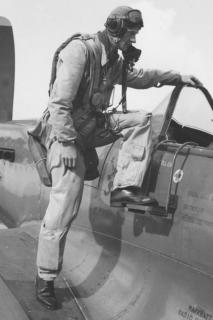
Transport Aircraft
Military transport aircraft are a type of cargo aircraft
used for transporting people and material.
List of Transport Aircraft in the Swedish Air
Force
Some of the Air Force transport aircraft:
•
Tp 16 - Caproni Ca 313, 2 in Swedish service 1940 -
1945
•
Tp 79 - Douglas DC-3, 8 in Swedish service 1949 -
1984
•
Tp 84 - Lockheed Martin C-130 Hercules, 8 in
Swedish service 1965 -
•
Tp 100 - Saab 340 2 in Swedish service 1997 -
•
Tp 102 - Gulfstream IV, 3 in Swedish service 1992 -
Lockheed Martin C-130 Hercules, Tp 84
The Lockheed C-130 Hercules is a four-engine
transport aircraft with turboprop engines.
The history of the aircraft begins with the Korean War
when the US Armed Forces needed a military
transport aircraft to move combat units over medium
distances. A further requirement was that the aircraft
should be able to operate from short and poor fields.
The aircraft first flew on 23 August 1954. Serial
deliveries to the USAF began in late 1956 under the
designation C-130. No other military aircraft have
been produced for as long a period as the C-130
Hercules.
The aircraft is a four-engine, high-wing aircraft with
short retractable landing gear to facilitate unloading
and reloading. At the rear of the fuselage is a large
hydraulic cargo ramp that can be opened in flight to
release equipment or parachutists.
In the early 1960s, the need for new transport aircraft
for the Swedish Armed Forces was investigated. The
Air Force first leased a Lockheed C-130E Hercules,
which was delivered to the Skaraborg Air Wing (F 7) in
early March 1965 and given the Swedish military
designation Tp 84. The aircraft was given the
individual number 841 in the Air Force and became
the first Hercules in service in a European country.
The aircraft was subsequently purchased by the Air
Force in September 1965. Since then, the Tp 84 has
always been based at the Transport Air Unit at
Skaraborg Air Wing (F 7) but carries out passenger
and material transport for the entire Armed Forces.
The aircraft was very flexible and when the next larger
transport aircraft was purchased in 1969, a Hercules
was again chosen. A third Hercules was purchased in
1975. The first two aircraft were of the E-variant while
the third was the H-variant, a later model. When the
Air Force increased the number of Hercules aircraft in
1981 with five additional Hercules aircraft, the H-
variant was again chosen. Later, the first two E aircraft
were modified so that all aircraft use the same
engines.
The Tp 84 Hercules can carry 20 tons of cargo, or
alternatively 92 passengers if troop seats are used.
When transporting fully equipped paratroopers, the
number of passengers is reduced to 56. As a medical
transport aircraft, it has room for 72 stretchers.
The aircraft belongs to the 71. Transport Aviation
Division at the Skaraborg Air Wing (F 7) in Såtenäs.
The parachute school in Karlsborg, with the Life
Regiment's Hussars (K 3), regularly uses the Tp 84 for
training parachutists.
Since 2010, air-to-air refueling capability has been
added to the Armed Forces by having one of the
Swedish Air Force's Hercules aircraft approved for
operational air-to-air refueling.
Swedish variants:
•
C-130E – engine: 4 x Allison T56-A-7 turboprop of
4,200 hp
•
C-130H – engine: 4 x Allison T56-A-15 turboprop of
4,590 hp
Specifications:
•
Length
29.8 m
•
Wingspan
40.4 m
•
Height
11.7 m
•
Empty weight
34.2 ton
•
Engines
4 x Allison T56-A-7 turboprop
of each 4,200 hp / 4 x Allison T56-A-15 turboprop
of 4,590 hp
•
Max. speed
583 km/h
•
Range
3,800 km
•
Max. flight altitude
10,000 meter (without load),
7,000 meter (with 19 tons load)
•
Load capacity
19.9 ton
•
Passengers
92 passengers
Image:
Swedish Lockheed C-130 Hercules Tp 84, marked 848,
on an airfield in front of a hangar at F 3 Malmen,
Sweden, in 1982. Image: Flygvapenmuseum, ID:
FVMF.003475.







